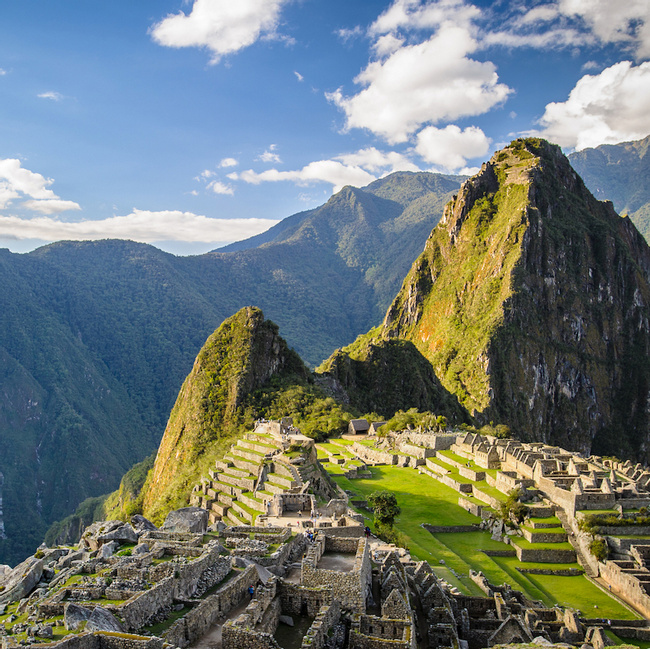- Travel Guides
Development and Society in Peru
After a turbulent 20th century, Peru progresses every year toward making the best use of its abundant natural resources and tourist attractions. Peru’s economy has been marked by a reliance on foreign powers — first under colonial rule and then through a series of trade agreements with other countries. In the 20th century, Peru dealt with an onslaught of intertwined political and economic difficulties, including communist insurgencies, authoritarian regimes, massive debt, and rapid inflation. By the early 1990s, the main terrorist groups had been largely disbanded, and the economy began to recover.

Quality of Life
In the early 2000s, Peru experienced rapid economic gains. With this progress came increased levels of education and health. Today, the average life expectancy in Peru is 74.5 years, and the literacy rate among adults is 89.6 percent. Educational resources have also expanded, and 97.1 percent of children are enrolled in school. Children in the city have a strong educational advantage over children in rural areas. Of underage workers in Peru, 68 percent of them live in rural areas, performing tasks related to agriculture and mining. 2012 marked the beginning of significant improvements in child labor laws, and stricter regulations will hopefully mean more education for children in agricultural communities.
Catholic social mores (Catholicsm is the predominant religion in Peru, albeit, comingled with indigenous beliefs) and a culture of machismo have preserved traditional gender roles in Peru. Divorce is still taboo, and married women usually remain in the domestic sphere. Open-air marketplaces — still one of the most common shopping destinations — are still predominantly run by women. As in many Latin American countries, large, close-knit families have regular get-togethers on weekends and during public holidays.
Economy and Employment
Peru has a large number of subsistence farmers, referred to as campesinos, and rural populations that still live in relative isolation throughout the Andes. Starting in the late 1960s, the divide between the upper class and the blue-collar workers began to shrink. In the past two decades, the Peruvian government and economy have made huge developments in infrastructure and increased transportation options have made it easier for tourists and natives alike to explore Peru’s many distinct environments and cultures.
Peru’s economy relies mostly on agriculture and its deposits of oil, minerals, and precious metals. Peru also exports a large amount of produce. Most of the produce ends up in South America, but some of it makes it as far as the U.S., thanks to a 2007 free trade agreement. Peru also has an abundance of natural resources, including zinc, copper, mercury, silver, and gold. Mining companies provide jobs to Peruvians, but Peruvian companies don’t typically own the resources. U.S. and Argentine companies own the pipelines extracting gas from the Amazon Basin.

The American corporation Halliburton owns the refinery at the Camisea gas fields, and the Colorado-based Newmont Mining Corporation operates the Yanacocha Gold Mine in northern Peru. From an environmental standpoint, many of these resources have not been properly managed.
Natural Disaster Setbacks
Several natural disasters have stymied healthy economic growth in Peru. Earthquakes wreak havoc in southern Peru, an area that sits on top of the shifting Nazca tectonic plate. Besides the immediate damage, these catastrophes have done long-term damage by destroying or damaging tourist attractions. For example, in 2001, an earthquake dismantled one of the towers of the 17th-century cathedral in Arequipa.

Other cities hit by severe earthquakes in the past decade include Pisco, Chincha, and Ica. At unpredictable intervals, a mysterious weather pattern called El Niño brings Peru to a standstill. In 1982 and 1998 devastating storms flooded parts of northern Peru. Both storms occurred at politically precarious times, making existing turmoil much worse.
Tourist Attractions and Preservation
One of Peru’s most diverse resources has faced a tremendous amount of damage. Unfortunately for the plants, wildlife and natives of the jungle, the Amazon is home to some highly-prized natural resources. Companies have started to extract oil from the Amazon Basin. Mobil Oil has started to explore opportunities in the Las Piedras and Candamo Valley — areas with indigenous groups and rare populations of plants and animals. Some Peruvians living near the jungle also participate in illegal deforestation.
The Manu National Park and Pacaya Samiria National Reserve are large reserves in the Amazon, both committed to preserving the Amazon and supporting ecotourism. In 2001, Peru started allowing community-managed conservation areas. The Chaparrí Ecological Reserve and Tamshiyacu Tahuayo Reserve are both successful examples of local governments stepping in to augment limited federal resources.
Despite the country's rich history and many attractions it wasn't until the late 1990s that Peru began to fulfill its potential as a tourist destination. 16 percent of Peru’s land is found in 68 protected areas. These areas get some funding from the government, and receive large donations from foreign organizations. The Peruvian government is also working to make sure popular tourist sites aren’t worn down by large numbers of visitors. In order to visit many monuments in the Cusco region, for example, you must purchase a tourist ticket. The government has also imposed limits on how many people can hike the Inca Trail at one time. This will hopefully ensure that growing numbers of visitors can continue to visit and admire all of Peru’s stunning attractions.

We believe travel is more than ticking destinations off a list – it’s about discovering new places deeply, feeling connected wherever you go, and knowing you have a trusted team behind you every step of the way.



